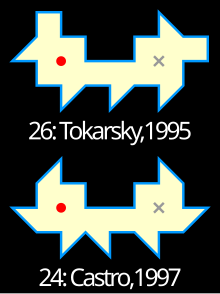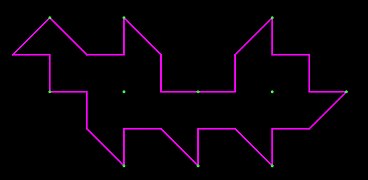| Revision as of 21:56, 19 December 2010 editLarryisgood (talk | contribs)Extended confirmed users1,168 editsNo edit summary← Previous edit | Latest revision as of 17:31, 30 August 2024 edit undoBhavya1805 (talk | contribs)1 editm Added the 20-sided unilluminable room from 1996.Tag: Visual edit | ||
| (105 intermediate revisions by 51 users not shown) | |||
| Line 1: | Line 1: | ||
| {{Short description|Mathematical problem}} | |||
| {{newpage}} | |||
| ]'s solution of the illumination problem using ] arcs (blue) and straight line segments (green), with 3 positions of the single light source (red spot). The purple crosses are the ] of the larger arcs. Lit and unlit regions are shown in yellow and grey respectively.]] | |||
| '''Illumination problems''' are a class of ]s that study the ] of rooms with ]ed walls by ]s. | |||
| ==Original formulation== | |||
| The |
The original formulation was attributed to ] in the 1950s and has been resolved. Straus asked whether a room with mirrored walls can always be illuminated by a single point light source, allowing for repeated reflection of light off the mirrored walls. Alternatively, the question can be stated as asking that if a ] can be constructed in any required shape, is there a shape possible such that there is a point where it is impossible to hit the ] at another point, assuming the ball is point-like and continues infinitely rather than stopping due to ]. | ||
| ==Penrose unilluminable room== | |||
| ⚫ | |||
| The original problem was first solved in 1958 by ] using ellipses to form the '''Penrose unilluminable room'''. He showed that there exists a room with curved walls that must always have dark regions if lit only by a single point source. | |||
| ==Polygonal rooms== | |||
| ] | |||
| ⚫ | This problem was also solved for ] rooms by George Tokarsky in 1995 for 2 and 3 dimensions, which showed that there exists an unilluminable polygonal 26-sided room with a "dark spot" which is not illuminated from another point in the room, even allowing for repeated reflections.<ref>{{Cite journal | ||
| | last = Tokarsky | | last = Tokarsky | ||
| | first = George | | first = George | ||
| ⚫ | | |
||
| | title = Polygonal Rooms Not Illuminable from Every Point | | title = Polygonal Rooms Not Illuminable from Every Point | ||
| | journal = American Mathematical Monthly | | journal = American Mathematical Monthly | ||
| | volume = 102 | | volume = 102 | ||
| | issue = 10 | | issue = 10 | ||
| | pages = |
| pages = 867–879 | ||
| | publisher = Mathematical Association of America | | publisher = Mathematical Association of America | ||
| | location = University of Alberta, Edmonton, Alberta, Canada | | location = University of Alberta, Edmonton, Alberta, Canada | ||
| | date = December 1995 | | date = December 1995 | ||
| | |
| jstor = 2975263 | ||
| | |
| doi=10.2307/2975263}}</ref> These were rare cases, when a finite number of dark ''points'' (rather than regions) are unilluminable only from a fixed position of the point source. | ||
| In 1995, Tokarsky found the first polygonal unilluminable room which had 4 sides and two fixed boundary points.<ref>{{Cite journal |last=Tokarsky |first=G. |date=March 1995 |title=An Impossible Pool Shot? |journal=] |location=Philadelphia, PA |publisher=Society for Industrial and Applied Mathematics |volume=37 |issue=1 |pages=107–109 |doi=10.1137/1037016}}</ref> He also in 1996 found a 20-sided unilluminable room with two distinct interior points. In 1997, two different 24-sided rooms with the same properties were put forward by George Tokarsky and David Castro separately.<ref>{{Cite journal | |||
| ⚫ | ] | ||
| | last = Castro | |||
| | first = David | |||
| | title = Corrections | |||
| | journal = ] | |||
| | volume = 7 | |||
| | issue = 3 | |||
| | pages = 42 | |||
| | publisher = Springer-Verlag | |||
| | location = Washington DC | |||
| | date = January–February 1997 | |||
| | url = http://static.nsta.org/pdfs/QuantumV7N3.pdf#page=44}}</ref><ref>{{Cite journal | |||
| ⚫ | | last = Tokarsky | ||
| | first = G. W. | |||
| | title = Feedback, Mathematical Recreations | |||
| | journal = ] | |||
| | volume = 276 | |||
| | issue = 2 | |||
| | pages = 98 | |||
| | publisher = Scientific American, Inc. | |||
| | location = New York, N.Y. | |||
| | date = February 1997 | |||
| | jstor = 24993618 | |||
| }}</ref> | |||
| In 2016, Samuel Lelièvre, Thierry Monteil, and Barak Weiss showed that a light source in a polygonal room whose angles (in degrees) are all rational numbers will illuminate the entire polygon, with the possible exception of a finite number of points.<ref>{{cite journal |last1=Lelièvre |first1=Samuel |last2=Monteil |first2=Thierry |last3=Weiss |first3=Barak |title=Everything is illuminated |journal=] |date=4 July 2016 |volume=20 |issue=3 |pages=1737–1762 |doi=10.2140/gt.2016.20.1737 |doi-access=free |arxiv=1407.2975 }}</ref> In 2019 this was strengthened by Amit Wolecki who showed that for each such polygon, the number of pairs of points which do not illuminate each other is finite.<ref>{{cite arXiv |last1=Wolecki |first1=Amit |title= Illumination in rational billiards |year=2019 |class=math.DS |eprint=1905.09358 }}</ref> | |||
| <gallery mode="packed"> | |||
| File:Boomerangroom.jpg|The first polygonal Tokarsky Unilluminable room with 4 sides, 1995. A showing the path of a billiard ball in this room. | |||
| File:Original-room.jpg|The Original Tokarsky Unilluminable Room with 24 sides, 1995. A showing the path of a billiard ball in this room. | |||
| File:Unilluminable room with 20 sides purple.png|An Unilluminable room with 20 sides, 1996. A showing the path of a billiard ball in this room. | |||
| File:Odd-sided-room.jpg|An Odd Sided Tokarsky Unilluminable Room with 27 sides, 1996. A showing the path of a billiard ball in this room. | |||
| </gallery> | |||
| == See also == | |||
| * ] | |||
| ==References== | ==References== | ||
| {{reflist}} | {{reflist}} | ||
| ==External links== | |||
| * , on ] by ], Feb 28, 2017 | |||
| * , on ] by ], May 19, 2022 | |||
| * "", on ] by Nils Berglund, Aug 13, 2022 | |||
| * , on ] by George Tokarsky, Jun 16, 2022 | |||
| * , on ] by George Tokarsky, Jul 15, 2022 | |||
| * , on ] by George Tokarsky, Jul 29, 2022 | |||
| * An , on ] | |||
| {{Roger Penrose|state=collapsed}} | |||
| ⚫ | ] | ||
| ] | |||
Latest revision as of 17:31, 30 August 2024
Mathematical problem
Illumination problems are a class of mathematical problems that study the illumination of rooms with mirrored walls by point light sources.
Original formulation
The original formulation was attributed to Ernst Straus in the 1950s and has been resolved. Straus asked whether a room with mirrored walls can always be illuminated by a single point light source, allowing for repeated reflection of light off the mirrored walls. Alternatively, the question can be stated as asking that if a billiard table can be constructed in any required shape, is there a shape possible such that there is a point where it is impossible to hit the billiard ball at another point, assuming the ball is point-like and continues infinitely rather than stopping due to friction.
Penrose unilluminable room
The original problem was first solved in 1958 by Roger Penrose using ellipses to form the Penrose unilluminable room. He showed that there exists a room with curved walls that must always have dark regions if lit only by a single point source.
Polygonal rooms

This problem was also solved for polygonal rooms by George Tokarsky in 1995 for 2 and 3 dimensions, which showed that there exists an unilluminable polygonal 26-sided room with a "dark spot" which is not illuminated from another point in the room, even allowing for repeated reflections. These were rare cases, when a finite number of dark points (rather than regions) are unilluminable only from a fixed position of the point source.
In 1995, Tokarsky found the first polygonal unilluminable room which had 4 sides and two fixed boundary points. He also in 1996 found a 20-sided unilluminable room with two distinct interior points. In 1997, two different 24-sided rooms with the same properties were put forward by George Tokarsky and David Castro separately.
In 2016, Samuel Lelièvre, Thierry Monteil, and Barak Weiss showed that a light source in a polygonal room whose angles (in degrees) are all rational numbers will illuminate the entire polygon, with the possible exception of a finite number of points. In 2019 this was strengthened by Amit Wolecki who showed that for each such polygon, the number of pairs of points which do not illuminate each other is finite.
-
 The first polygonal Tokarsky Unilluminable room with 4 sides, 1995. A video showing the path of a billiard ball in this room.
The first polygonal Tokarsky Unilluminable room with 4 sides, 1995. A video showing the path of a billiard ball in this room.
-
 The Original Tokarsky Unilluminable Room with 24 sides, 1995. A video showing the path of a billiard ball in this room.
The Original Tokarsky Unilluminable Room with 24 sides, 1995. A video showing the path of a billiard ball in this room.
-
 An Unilluminable room with 20 sides, 1996. A video showing the path of a billiard ball in this room.
An Unilluminable room with 20 sides, 1996. A video showing the path of a billiard ball in this room.
-
 An Odd Sided Tokarsky Unilluminable Room with 27 sides, 1996. A video showing the path of a billiard ball in this room.
An Odd Sided Tokarsky Unilluminable Room with 27 sides, 1996. A video showing the path of a billiard ball in this room.
See also
References
- Tokarsky, George (December 1995). "Polygonal Rooms Not Illuminable from Every Point". American Mathematical Monthly. 102 (10). University of Alberta, Edmonton, Alberta, Canada: Mathematical Association of America: 867–879. doi:10.2307/2975263. JSTOR 2975263.
- Tokarsky, G. (March 1995). "An Impossible Pool Shot?". SIAM Review. 37 (1). Philadelphia, PA: Society for Industrial and Applied Mathematics: 107–109. doi:10.1137/1037016.
- Castro, David (January–February 1997). "Corrections" (PDF). Quantum Magazine. 7 (3). Washington DC: Springer-Verlag: 42.
- Tokarsky, G. W. (February 1997). "Feedback, Mathematical Recreations". Scientific American. 276 (2). New York, N.Y.: Scientific American, Inc.: 98. JSTOR 24993618.
- Lelièvre, Samuel; Monteil, Thierry; Weiss, Barak (4 July 2016). "Everything is illuminated". Geometry & Topology. 20 (3): 1737–1762. arXiv:1407.2975. doi:10.2140/gt.2016.20.1737.
- Wolecki, Amit (2019). "Illumination in rational billiards". arXiv:1905.09358 .
External links
- "The Illumination Problem – Numberphile", on YouTube by Numberphile, Feb 28, 2017
- "Penrose Unilluminable Room Is Impossible To Light", on YouTube by Steve Mould, May 19, 2022
- "The mushroom's shape does not matter in Penrose's unilluminable room", on YouTube by Nils Berglund, Aug 13, 2022
- "The Tokarsky original unilluminable room with 24 sides", on YouTube by George Tokarsky, Jun 16, 2022
- "Egyptian hieroglyphs: An Odd Tokarsky unilluminable room", on YouTube by George Tokarsky, Jul 15, 2022
- "Eureka! The first polygonal unilluminable room", on YouTube by George Tokarsky, Jul 29, 2022
- An interactive demonstration, on Wolfram demonstrations project